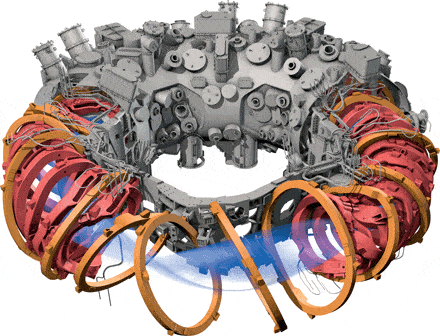German scientists have turned on a device called a stellerator, the largest of its kind. The machine could pave the way for nuclear fusion, a clean and safe type of nuclear power.

This machine, called W7-X, cost approximately $1.1 billion, has a diameter of 52 feet (16 meters) and took 19 years to construct; the GIF above shows the layers of the machine.
Nuclear fusion
As we were telling you before, a stellarator is a device used to confine a hot plasma with magnetic fields in order to sustain a controlled nuclear fusion reaction. The basic idea is that the differing magnetic fields will cancel out the net forces on a particle as it travels around the confinement area. They were quite popular in the 50s and 60s, but their popularity greatly decreased in following decades, as other types of fusion research were carried.
The key is to create ungodly high temperatures up to 180 million degrees Fahrenheit (100 million Celsius) and generate, confine, and control a blob of gas, called a plasma. At these incredibly high temperatures, the very structure of the atom changes, and the electrons are ripped from the outer shells, leaving positive ions. Normally, these ions would just bounce off each other, but under these conditions, they can merge together, creating new atoms, and – BAM – you have nuclear fusion. Nuclear fusion shouldn’t be mistaken for the nuclear energy we are using at the moment, which generate energy from decaying atoms, not atoms that fuse together.
Fusion is the process that powers our Sun, and if we could somehow harvest that power, then it could (in time) be a green energy revolution.
“It’s a very clean source of power, the cleanest you could possibly wish for. We’re not doing this for us, but for our children and grandchildren,” one of the team, physicist John Jelonnek from the Karlsruhe Institute of Technology, said in a statement.
Flipping the switch
The 425-tonne machine took 19 years to construct, requiring 1.1 million construction hours in total. However, it seems to have been worth it as the first tests were carried smoothly.
“Everything went well today,” said Robert Wolf, a senior scientist involved with the project. “With a system as complex as this you have to make sure everything works perfectly and there’s always a risk.”
So far, the team was able to heat hydrogen gas to 80 million degrees for a quarter of a second. This might not sound like much, but it’s a clear proof of concept as well as an indication of things to come. Experiments will continue and a divertor for the elimination of impurities will be mounted inside the reactor, allowing plasmas to last as long as 30 minutes.
It has to be said, the device itself won’t generate useful amounts of energy, but it will (hopefully) demonstrate that this can be done realistically.
“In a later phase of W-X, starting in 2019, we will use deuterium and we will get fusion reactions, but not enough to get more energy out than we are putting in,” one of the team, Hans-Stephan Bosch, said, adding that there are no plans to add tritium to the hydrogen plasma to break even.










